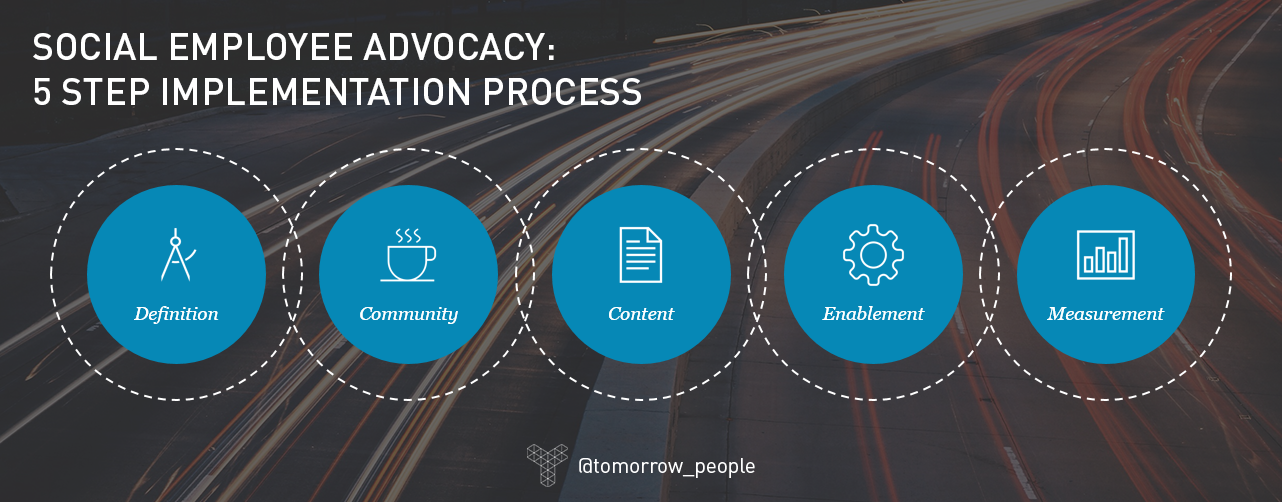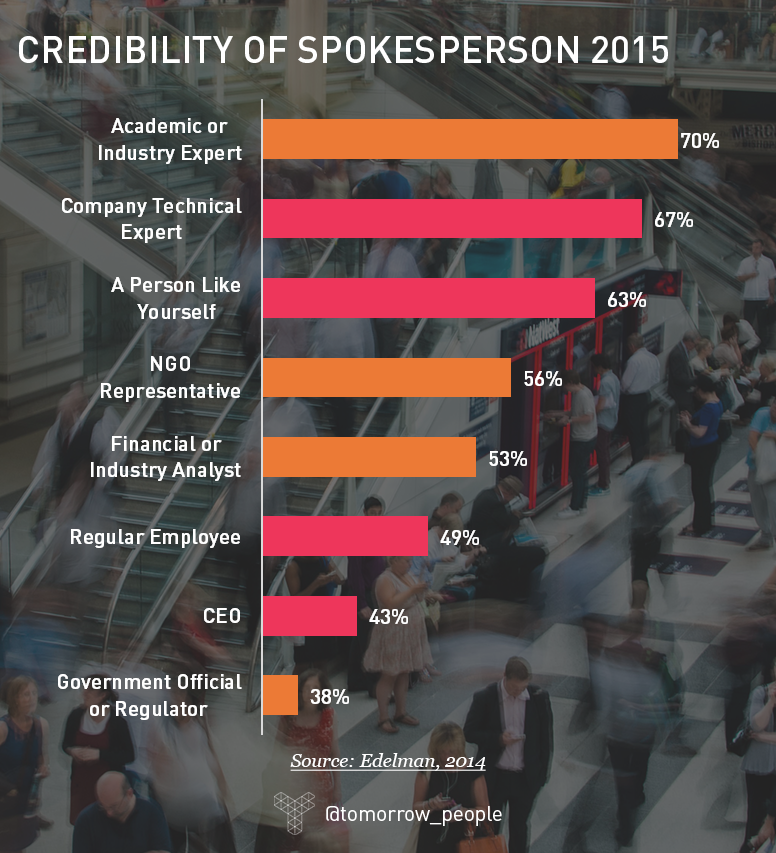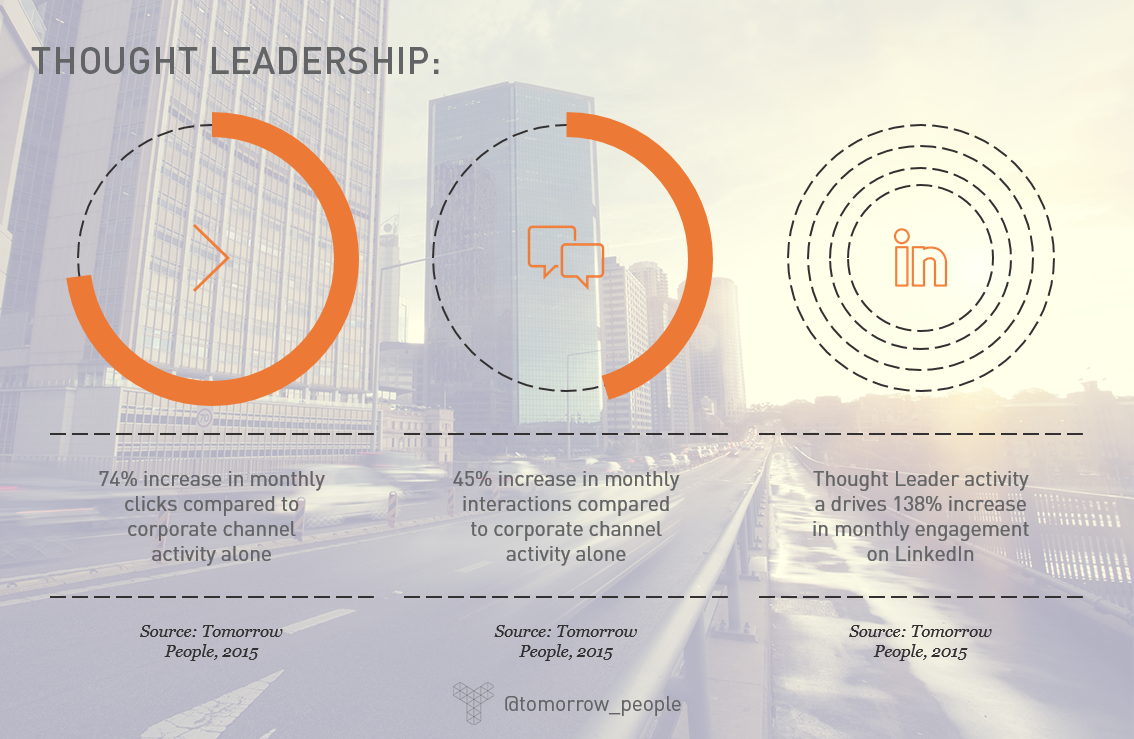
The Social Enterprise: A 5-step Guide to Implementing Social Employee Advocacy
Your employees could be the greatest untapped marketing resource you have. In the 2nd part of this presentation from the B2B Marketing Summit 2015 we look at the key elements involved in implementing an effective social employee advocacy programme.
This is the second part of a two part post on social media and employee advocacy – catch up with part one here.
In the second part of this feature, we’re going to look at you can start utilising social employee advocacy, with 5 steps to implementing a social employee advocacy programme at your organisation – definition, community, content, enablement and measurement. Whether you’re working with a team of 20 or a network of 20,000, the principles remain the same, and this process can be scaled to your needs.

 Step 1: Define
Step 1: Define
As with any other marketing initiative, the most important initial step is to define what you plan to do, why you plan to do it, and what you plan to achieve.
The following key questions are useful prompts when considering the scope of your employee advocacy programme:
-
Who needs to be involved internally, and who are the key stakeholders?
-
How are employees currently using social media? What channels are the most active?
-
What are the key drivers for social employee advocacy? What are we hoping to achieve?
-
What are the key milestones for implementation and delivery?
-
How will the programme be governed and moderated internally? What are the main risk factors?
-
What guidelines, tools and/or systems do we need to provide for employees to facilitate the programme?
It’s important to remember that amplifying existing behaviours is far easier than trying to drive adoption of new behaviours; for example, if your employees are active on LinkedIn but do not use Twitter, focusing your efforts on LinkedIn is likely to have better results.
When setting objectives and milestones, be realistic; whilst an increase in ROI might your long term aim, it might be difficult to attribute direct sales to your social employee advocacy programme in the first month after launch, for example. However, you will be able to report on things like the rate of adoption and volume of employee engagement. Setting high expectations might make your employee advocacy programme easier to sell to the board, but it also leaves it wide open to failure. Start with small, simple metrics and goals, and work your way up from there.
The start small rule applies especially to enterprise companies and organisations, with large numbers of employees and complex internal structures. A modest, successful employee advocacy programme that can be scaled up is far more effective, more impressive and easier to justify than an ambitious, failed programme. Focus on a single market, division or team and test what works and what doesn’t, from both delivery and performance perspectives. Utilise these lessons to expand and build on your programme, with a structured rollout plan.
Social media policy is a recurring sticking point for companies when it comes to employee social media usage, but it comes down to deciding what you are comfortable with as a company. In most cases, a set of broad guidelines covering any major dos and don’ts is more than enough.
The definition phase shouldn’t be a siloed activity restricted to the marketing department. Your social employee advocacy programme will be much stronger if you include your colleagues and co-workers in the process, ensuring that the programme works for them as much as it works for you.
 Step 2: Community
Step 2: Community
Creating a network of employee advocates has a lot in common with building a successful email marketing programme – you can have the biggest email database in the world, but if everybody opts out then there is no value in it. Establishing a social committee is a great way to start building an opt-in culture around your employee advocacy programme.
A social media committee should represent a cross-section of departments, roles and levels, facilitating communication and acting as a go-between to promote your social advocacy programme to a wider network of employees. Building a strong committee can be a catalyst driving adoption of an employee advocacy programme across your organisation, so look for influencers and leaders to take part – people who get involved in organising charity events and office socials tend to be a good fit for this, as they’re naturally great at encouraging their colleagues to take part and creating some internal buzz.
Typically, we find there are four different types of employee advocates; thought leaders, social champions, promoters and consumers.

Thought Leaders are senior figures within your organisation, who hold a position of authority either due to their role at the company, their expertise in a particular area, or their profile in a certain sector.

They have the greatest potential influence on your target audience, but they also require the most investment in terms of content, support and management. Their profile isn’t the only consideration however – candidates who have some knowledge of social media, or at least a desire to learn, tend to be better suited, as their genuine engagement and enthusiasm clearly comes across to the audience. Thought leaders are the voice of your company – however, they don’t have to be exclusively from the C-Suite.
In fact, Edelman’s most recent Trust Barometer report suggests that looking beyond the C-Suite for spokespeople might be even more effective, with people ranking technical experts and their peers as far more credible than the CEO.
At Tomorrow People, we use our client’s thought leaders as authors for our content, across branded blogs and also external industry media sites and publications, and and also to promote content across their Twitter and LinkedIn profiles. In the 9 months between September 2014 and May 2015, our thought leadership programme generated an average 74% increase in monthly clicks and 45% increase in monthly interactions for our clients, compared to corporate channel activity alone.
It’s been especially effective on LinkedIn, where utilising personal profiles and getting involved in discussion groups has helped us drive an average 138% increase in monthly engagement against corporate channels alone. Typically, we manage thought leader accounts for 2-4 individuals per client, so imagine the additional reach that your company could be enjoying by utilising an even wider base of employees.

The second level of advocates are your social champions – they may not have as high a profile as your thought leaders, but they are active on social media and they are active within your company. Social champions are important because they can dramatically increase your reach and encourage adoption – look for influencers within your organisation, people who are already active on social, have a blog, or are involved in industry bodies.
Although in the lower half of the diagram, promoters and consumers are still vital, and require the lightest touch in terms of investment. Promoters might not get as engaged as thought leaders or social champions, but they will share your branded content via their own channels and can be a vital element in extending reach. Consumers have a more passive relationship – they might follow your channels and read your updates, but probably won’t get too involved beyond that.
That’s not a problem – any advocacy programme should be completely voluntary, so there will be people who don’t want to take part. Forcing employees to share an obligatory tweet about your latest blog post does nothing to foster engagement, and it’s easy to spot disingenuity on social. Focus on the people who do want to take part, and aim, in the longer term, to transform passive participants into consumers, and consumers into promoters, thereby extending your reach even further.
 Step 3: Content
Step 3: Content
So, you’ve defined your programme, identified your thought leaders, and your social committee are busy rallying the troops. The next step is to ensure your team of social advocates actually have some content to share!
Your employees are much more likely to get involved on social if you provide them with a selection of content they can easily engage with.There are three ways to do this:
- create original content. This can include internal updates such as job vacancies, new products and features, and sales and promotional messages. Assets such as industry reports or white papers can also be a valuable source of ongoing content for your employees.
- collect content from across your organisation. Collected content rounds up all the great stories that are already happening in your company. Celebrate employee achievements, highlight any social or cultural events taking place, and share customer successes and case studies.
- curate content from external sources. Look outside your own channels and pull in content from the wider industry – not only does this give you great content to share, it also aligns your brand to industry leaders and influencers, and helps to build relationships with them.
Using all three techniques ensures a more rounded tone of voice, and avoids placing too much emphasis on sales and promotional messages.
Remember to keep an eye out for existing assets and content being created across departments that could be repurposed for your employees – maybe your product team just ran a customer feedback survey, for example, that would make a great infographic.
 Step 4: Enablement
Step 4: Enablement
Probably the most important element of your social advocacy programme is how you enable your employees to get involved and empower them to become social advocates. The most important element of this is education.

To paraphrase the famous saying, “Give a man a tweet, he can retweet it. Teach him how to be an influencer on Twitter, he can promote your brand to a network of followers on an ongoing basis…”. Providing training and education on how to use social media not only helps the success of your programme, it also helps your employees build new skills and increases employee engagement as you invest in them. Giving your team the knowledge they need has a huge effect on encouraging engagement and adoption.
There are a host of tools and platforms that will help you manage an employee advocacy programme, but the simplest techniques are a good place to start, and require the least investment – add a section to your employee intranet, create a Twitter list of your employees, or add a footer to internal emails encouraging people to get involved. At Tomorrow People, we’re setting up a weekly email newsletter with the latest content, news and updates from the agency that our employees can share with their own channels.
The key is to make taking part as friction-less as possible – for example, add sharing buttons to your emails complete with pre-populated tweets, hashtags and tracking links, so advocates can share on-brand messaging with one click instead of having to open Twitter and create their own post.
If you want to go further, there are several tools and platforms to facilitate employee advocacy, from free solutions to paid enterprise level solutions, making it much easier to monitor the progress and performance of your programme from one central place.
 Step 5: Measurement
Step 5: Measurement
The final step of the process is measurement. You have your scope, your social committee, your content and all your processes in place – it’s now time to see if it’s all working.
There are four key areas we measure at Tomorrow People when it comes to employee advocacy:
- Engagement – how are your employees engaging with the programme, and how are they influencing others to take action? Key metrics include employee adoption, volume of posts, likes and comments.
- Awareness – how are your employees increasing the footprint of your brand online? Key metrics include volume of brand mentions and conversation sentiment.
- Traffic – how is your employee advocacy driving traffic and leads back into your sales funnel? Key metrics include clicks, referrals, leads and opportunities.
- Reach – how are your employee increasing the reach of your marketing beyond your own channels? Key metrics include combined audience and social shares.
The most important thing to remember when it comes to measuring social media advocacy is to track everything – keep a record of which employees are involved, and what messages they are sharing. IFFT is a great way to do this, as you can track your employee’s tweets into a google spreadsheet. It’s well worth setting up tracking links to understand which of your campaigns is driving traffic back to your website – if you’re not sure how to get started with UTM tags, use a service like bit.ly to shorten your URLs and track clicks automatically.
Done well, employee advocacy can really have an effect on your social media performance, and there are simple elements of this programme that you can implement quickly and easily to start seeing results. Here’s a recap of the key points:
Takeaways
- Your employees have potential to be influencers for your brand, and are currently underutilised in B2B marketing
- Appoint a social committee to drive social engagement and advocacy across your organisation at all levels
- There are different types of advocate, from senior thought leaders to passive consumers, and all have a role to play in your marketing initiatives
- Build an opt-in culture around your social advocacy programme, led by social champions
- Start small and simple – education is key
- Track everything, measure everything
This is the second part of a two part post on social media and employee advocacy – catch up with part one here.
How socially engaged are your employees? Take our employee advocacy survey to benchmark your performance.
Read the latest positioning trends and insights.
Tap into our brand and product positioning, storytelling, and creative expertise to inspire your next strategic move.
 This is the second part of a two part post on social media and employee advocacy –
This is the second part of a two part post on social media and employee advocacy – 

